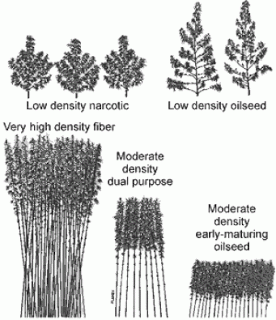

| Online: | |
| Visits: | |
| Stories: |
Difference between Industrial Hemp and Cannabis
by Hempethics
The difference is in its use. Hemp and Marijuana both come from the same plant – Cannabis Sativa L. The term 'Hemp' commonly refers to the industrial/commercial use of the cannabis stalk and seed for textiles, foods, papers, body care products, detergents, plastics and building materials. The term 'marijuana' refers to the medicinal, recreational or spiritual use involving the smoking of cannabis flowers. Industrial hemp contains only about 0.3% – 1.5% THC (Tetrahydrocannabinoids, the intoxicating ingredients that make you high) while marijuana contains about 5% – 10% or more THC. Hemp fibre is the longest, strongest and most durable of all natural fibres. Hemp cultivation requires no chemicals, pesticides or herbicides. Grown in rotation with other crops such as corn and legumes, hemp farming is completely sustainable. Hemp produces four times as much fibre per acre as pine trees. Hemp tree-free paper can be recycled up to seven times, compared with three times for pine-pulp based papers. Hemp is easy to grow, and actually conditions soil where it grows. The seed and seed-oil are high in protein, essential fatty and amino acids, and vitamins. Hemp would be an ideal source of biomass for fuel, and hemp Ethanol burns very cleanly.
Hemp and humanity have been linked for over 10,000 years. Hemp was our first agricultural crop, and remained the planet's largest crop and most important industry until late last century. Most of the non-Western world never stopped growing hemp, and today hemp for commercial use is grown mostly by China, Hungary, England, Canada, Australia, France, Italy, Spain, Holland, Germany, Poland, Romania, Russia, Ukraine, India and throughout Asia.
Differences Between Industrial Hemp and Marijuana
Industrial hemp is a variety of cannabis sativa that has a long history of use in the United States.
However, since the 1950s it has been lumped into the same category of marijuana, and thus the extremely versatile crop was doomed in the United States. Industrial hemp is technically from the same species of plant that psychoactive marijuana comes from. However, it is from a different variety, or subspecies that contains many important differences. The main differences between industrial hemp and marijuana will be discussed below.
Industrial hemp has low THC levels compared to marijuana specifically cultivated for personal psychoactive use. Whereas marijuana that can be smoked usually contains between five and ten percent THC, industrial hemp contains about one-tenth of that. In order to get a psychoactive effect, one would need to smoke ten or twelve hemp cigarettes over a very short period of time. The reason for the low THC content in hemp is that most THC is formed in resin glands on the buds and flowers of the female cannabis plant. Industrial hemp is not cultivated to produce buds, and therefore lacks the primary component that forms the marijuana high. Furthermore, industrial hemp has higher concentrations of a chemical called Cannabidiol (CBD) that has a negative effect on THC and lessens its psychoactive effects when smoked in conjunction.
Read more »
Source: http://www.riseearth.com/2014/11/difference-between-industrial-hemp-and.html




